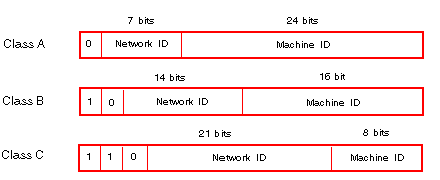On a TCP/IP Ethernet network, each device must have a unique IP address.This address is made up of two identifiers, one of which identifies the network, while the other identifies the connected machine.
The uniqueness of the addresses is managed as follows:
-
When the network environment is of open type, the uniqueness of the address is guaranteed by the attribution of a network identifier by the relevant authority in the country where the network is located,
-
If the type of environment is closed, the uniqueness of the address is managed by the company's network manager.
An IP address is defined as 32 bits. It consists of 4 numbers, one for each byte of the address.
NOTE: Standardized and made common largely thanks to the Internet, IP addressing is described in detail in RFCs (Request For Comment) 1340 and 791 which stipulate the Internet standards as well as in computing manuals describing networks. You can refer to these sources for further information.
Depending on the size of the network, three classes of address can be used:
Spaces reserved for the different classes of IP addresses:
|
Class
|
Range
|
|
A
|
0.0.0.0 to 127.255.255.255
|
|
B
|
128.0.0.0 to 191.255.255.255
|
|
C
|
192.0.0.0 to 223.255.255.255
|
-
Class A addresses are intended for large-scale networks which have a large number of connected sites.
-
Class B addresses are intended for medium-scale networks which have fewer connected sites.
-
Class C addresses are intended for small-scale networks which have a small number of connected sites.
Sub-Addressing and Sub-Network Mask
An IP address is composed of two identifiers, one of which identifies the network while the other identifies the connected machine. In reality, the machine identifier can also hold a sub-network identifier.
In an open environment, having received a network identifier from the relevant authority, the local system administrator has the possibility of managing many networks. This means that local networks can be installed without having any effect on the external world, which still sees just one network designated by the network identifier.
The sub-network mask makes it possible to see the number of bits attributed respectively to the network identifier and to the sub-network identifier (bits at 1), and then to the machine identifier (bits at 0).
Example: 140.186.90.3
The segmentation allows for 254 possible sub-networks with 254 sub-network machines.
The value of the sub-network mask should be chosen so that it is consistent with the IP address class.
The sub-network mask will have the following value:
-
for a class A address: 255.xxx.xxx.xxx,
-
for a class B address: 255.255.xxx.xxx,
-
for a class C address: 255.255.255.xxx,
xxx is an arbitrary value which can be chosen by the user.
The term Gateway is used in this manual in the sense of "router". If the target machine is not connected to the local network, the message will be sent to the "default gateway" connected to the local network, which will guarantee routing to another gateway or towards its final destination.

